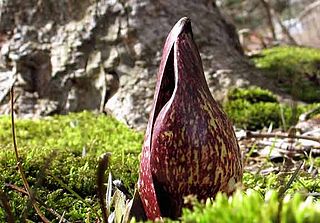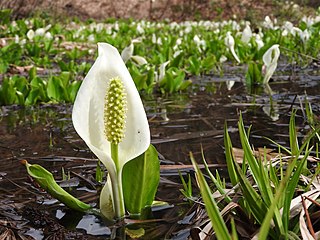
Trillium is a genus of about fifty flowering plant species in the family Melanthiaceae. Trillium species are native to temperate regions of North America and Asia, with the greatest diversity of species found in the southern Appalachian Mountains in the southeastern United States.

The Araceae are a family of monocotyledonous flowering plants in which flowers are borne on a type of inflorescence called a spadix. The spadix is usually accompanied by, and sometimes partially enclosed in, a spathe or leaf-like bract. Also known as the arum family, members are often colloquially known as aroids. This family of 140 genera and about 3750 known species is most diverse in the New World tropics, although also distributed in the Old World tropics and northern temperate regions.

Tradescantia is a genus of 85 species of herbaceous perennial wildflowers in the family Commelinaceae, native to the Americas from southern Canada to northern Argentina, including the West Indies. Members of the genus are known by many common names, including inchplant, spiderwort, and dayflower. The common name wandering Jew is controversial, and some vendors and bloggers have chosen to refer to it as wandering dude.

Jasmine is a genus of shrubs and vines in the olive family (Oleaceae). It contains around 200 species native to tropical and warm temperate regions of Eurasia, Africa, and Oceania. Jasmines are widely cultivated for the characteristic fragrance of their flowers. A number of unrelated plants contain the word "jasmine" in their common names.

Symplocarpus foetidus, commonly known as skunk cabbage or eastern skunk cabbage, is a low growing plant that grows in wetlands and moist hill slopes of eastern North America. Bruised leaves present an odor reminiscent of skunk.

Symplocarpus is a genus of flowering plants in the family Araceae, native to United States, Canada and eastern Asia. The genus is characterized by having large leaves and deep root systems with contractile roots used for changing the plant's level with the ground. Symplocarpus species grow from a rhizome and their leaves release a foul odor when crushed.

Zoysia is a genus of creeping grasses widespread across much of Asia and Australia, as well as various islands in the Pacific. These species, commonly called zoysia or zoysiagrass, are found in coastal areas or grasslands. It is a popular choice for fairways and teeing areas at golf courses. The genus is named after the Slovenian botanist Karl von Zois (1756–1799).

Nyctaginaceae, the four o'clock family, is a family of around 33 genera and 290 species of flowering plants, widely distributed in tropical and subtropical regions, with a few representatives in temperate regions. The family has a unique fruit type, called an "anthocarp", and many genera have extremely large pollen grains.

Selenicereus, sometimes known as moonlight cactus, is a genus of epiphytic, lithophytic, and terrestrial cacti, found in Mexico, Central America, the Caribbean and northern South America. The term night-blooming cereus is also sometimes used, but this is also used for many night-blooming cacti, including Epiphyllum and Peniocereus. In 2017, the genus Hylocereus was brought into synonymy with Selenicereus. A number of species of Selenicereus produce fruit that is eaten. The fruit, known as pitaya or pitahaya in Spanish or as dragon fruit, may be collected from the wild or the plants may be cultivated.

Muehlenbeckia or maidenhair is a genus of flowering plants in the family Polygonaceae. It is native to the borders of the Pacific, including South and North America, Papua New Guinea and Australasia. It has been introduced elsewhere, including Europe. Species vary in their growth habits, many being vines or shrubs. In some environments, rampant species can become weedy and difficult to eradicate.

Carrion flowers, also known as corpse flowers or stinking flowers, are mimetic flowers that emit an odor that smells like rotting flesh. Apart from the scent, carrion flowers often display additional characteristics that contribute to the mimesis of a decaying corpse. These include their specific coloration, the presence of setae and orifice-like flower architecture. Carrion flowers attract mostly scavenging flies and beetles as pollinators. Some species may trap the insects temporarily to ensure the gathering and transfer of pollen.

Daphniphyllum is the sole genus in the flowering plant family Daphniphyllaceae and was described as a genus in 1826. The genus includes evergreen shrubs and trees mainly native to east and southeast Asia, but also found in the Indian Subcontinent and New Guinea.

Lysichiton americanus, also called western skunk cabbage (US), yellow skunk cabbage (UK), American skunk-cabbage or swamp lantern, is a plant found in swamps and wet woods, along streams and in other wet areas of the Pacific Northwest, where it is one of the few native species in the arum family. The plant is called skunk cabbage because of the distinctive "skunky" odor that it emits when it blooms. This odor will permeate the area where the plant grows, and can be detected even in old, dried specimens. The distinctive odor attracts its pollinators, scavenging flies and beetles. Although similarly named and with a similar smell, the plant is easy to distinguish from the eastern skunk cabbage, another species in the arum family found in eastern North America.

Linnaea is a plant genus in the honeysuckle family Caprifoliaceae. Until 2013, the genus included a single species, Linnaea borealis. In 2013, on the basis of molecular phylogenetic evidence, the genus was expanded to include species formerly placed in Abelia, Diabelia, Dipelta, Kolkwitzia and Vesalea. However, this is rejected by the majority of subsequent scientific literature and flora.

Lysichiton camtschatcensis, common name Asian skunk-cabbage, white skunk cabbage, Far Eastern swamp lantern or Japanese swamp lantern, is a plant found in swamps and wet woods, along streams and in other wet areas of the Kamchatka Peninsula, the Kuril Islands, Sakhalin and northern Japan. The common name "skunk cabbage" is used for the genus Lysichiton, which includes L. americanus, the western skunk cabbage, noted for its unpleasant smell. The Asian skunk cabbage is more variable: plants have been reported in different cases to smell disgusting, not at all, and sweet. In Japanese it is known as mizubashō from a supposed similarity to the Japanese banana, a name with poetic rather than malodorous associations. It is not closely related to the true cabbage.

Discospermum is a genus of flowering plants in the family Rubiaceae. The genus is found from India to the Philippines.
Serruria cyanoides, the Wynberg spiderhead, is a flower-bearing shrub that belongs to the genus Serruria and forms part of the fynbos.
Diastella myrtifolia, the Tulbagh silkypuff, is a flower-bearing shrub that belongs to the genus Diastella and forms part of the fynbos. The plant is native to the Western Cape and is found in the Groot Winterhoek. The shrub is erect to semi-erect with mat-shaped spreading branches.

Spatalla racemosa, the lax-stalked spoon, is a flower-bearing shrub that belongs to the genus Spatalla and forms part of the fynbos. The plant is native to the Western Cape where it is found in the Kogelberg, Groenlandberg, Babilonstoringberge, Kleinrivierberge as well as at Villiersdorp.
Monstera dissecta is a species of flowering plant in the genus Monstera and family Araceae.
















